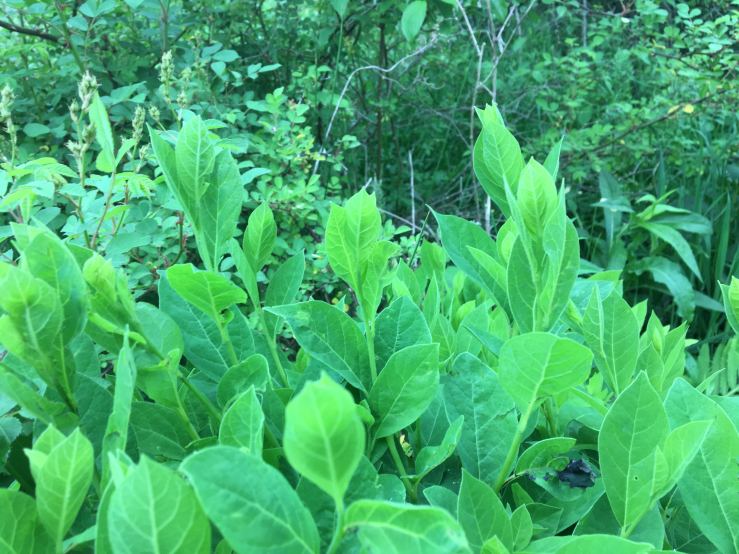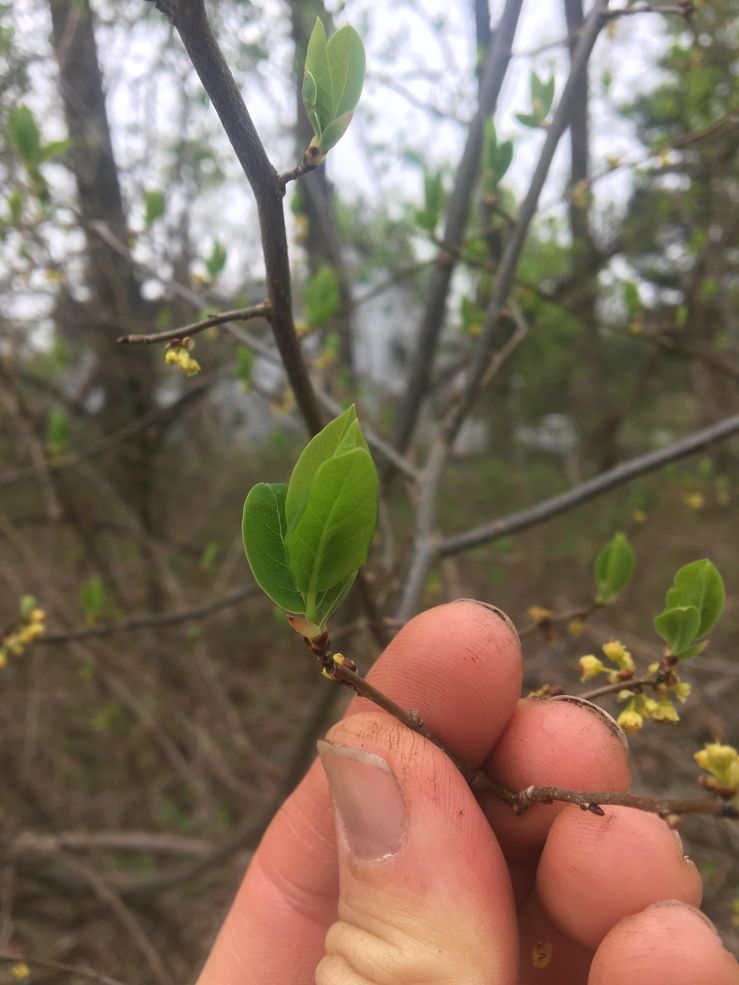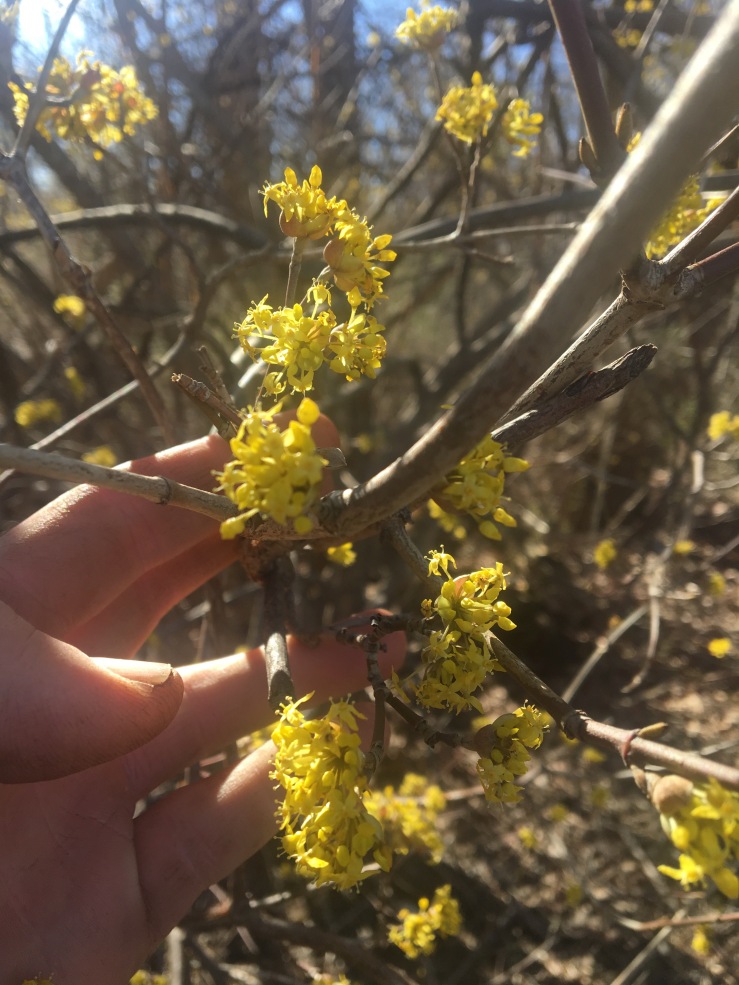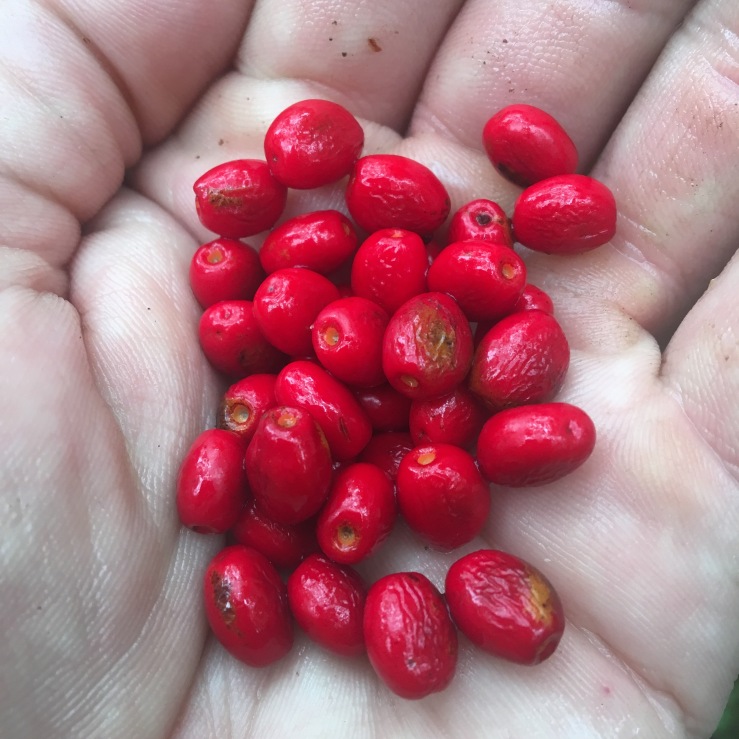
Our native spicebush (Lindera benzoin) is a plant that greatly exceeds expectations. It passes by quite unnoticed along many a hiking trail or watershed. It’s precisely the kind of thing you don’t take notice of until you are looking for it. Immediately afterwards, you realize it is everywhere. At least, it’s everywhere if you live by me. If you live in the broader eastern half of the United States, then you are within its’ range, from Maine to northern Florida, west to Texas and Iowa. That doesn’t mean you’ll see it as often as I do–but you may see it often enough to consider collecting it for use as a food and seasoning.
If you can, if you do, you will find an ingredient that will constistantly surprise you with how intense its flavor is, and how pliable and useful that flavor is in the kitchen. This humble bush has a lot going for it. A lot more than at first might meet the eye, or indeed, tongue.

Spicebush is an understory plant, a deciduous shrub, and a native plant. It can be found in areas dominated by deciduous hardwoods–spicebush flowers in the early spring and sets fruit early, so it needs the canopy above to be relatively free of evergreen foliage. It tends to congregate along paths, trails and natural clearings, anywhere it can get a little extra light during the growing season. Its leaves are soft and fairly large, with a distinctive fragrance that echoes the flavors and aromas to be found in the other parts of the plant. It should be abundant, if you wish to collect flowers or fruit (“spicebush berries or spiceberries”). If not, sampling a handful of leaves or a few winter twigs won’t harm the plant much. Because it grows so profusely along hiking trails in my area, I collect it at state and national parks (HEAVEN FORFEND) where the park rangers already clearly maintain a trail. Essentially, I do their pruning for them, snapping back intruding twigs in winter and collecting fruit most likely to fall in an area where constant travel would impede their growth. Look for spicebush flowers in late winter/early spring, leaves by mid-spring, and green fruit by late spring. By late summer, sometimes even mid-summer if it is particularly hot, the fruit will turn red and mature, and the leaves will gradually begin to yellow, and will drop off in the fall.
Spicebush provides a year-round culinary source, since all of its aboveground material is useful, even down to the hardy winter twigs. The fresh growth of twig can be collected and used at any time of the year, but I mainly use it during the winter, when other ingredients are scarce and the plants energy is concentrated in the fresh growth. I also collect twigs when I harvest whole branches of the plant, which I generally do if I am planning on using every part–leaves, twigs and berries.

In early spring comes the flower of spicebush, the part I have used least for seasoning but the part of the plant that most people are familiar with. In locations with strong spicebush populations, the woods become a veritable sea of wispy yellow flowers, small and innocuous on close inspection but vibrant when they have so little competition from other leaves or flowers. My initial experimentation with spicebush flower has been very positive and made me excited for more–I infused flowers and twigs in both vinegar and Mirin, and found that these each had an intriguing flavor, not exactly the same as when other parts of the plant were used, but warmer and sweeter. I expect I will use the flowers with great gusto next season.
Spicebush provides not one, but two dried spices : one sharp and peppery in spring, one savory and spicy in the fall. Unusually, both of these can also be used fresh, as the basis for curry or spice pastes, or preserved whole a la capers.

Green spicebush berries can be collected as soon as they emerge, and their flavor at first will be especially peppery and citrusy., and biting into one in the woods might make you think you found wild black pepper! I would almost rate this initial stage as a third dried spice, but the size of the berries when they have this intensity of flavor is quite small. As the size of the berries increases, the flavor begins slowly to broaden out. The prime time for collecting the green berries is when they are fully-sized but before the berries begin to turn red, usually up until early August. They can be used fresh to make curry or spice pastes, pickled or fermented a la capers, or dried. I usually dry them in my dehydrator on a fruit-roll up tray, but I have air-dried them successfully as well. Tradition states that spicebush should be stored in the refrigerator, as the berries are high in fats and may spoil, but I haven’t found this to be the case with the green fruits, which dry down to a much more shriveled-up size. In dry or especially hot seasons, you may find spicebush berries turning red in July, but this is a sign of stress in specific plants, rather than a general indicator of harvest time. Before the berries change color, the flavor begins to swing, from peppery and lemony to sweet and resiny, with a hint of the aromatic spice of cinnamon or clove. When the berries have deepened to a rich, bright red, it is time to begin collecting them again.

Red spicebush berries are a sweeter spice, almost reminiscent of allspice, to which they are often compared. While allspice is quite fine, to me dried red spicebush has a more complex, daring and interesting flavor, with more sharp and resinous notes. The fresh red berries can be used as well, and I make curry pastes and spice pastes with those, combining with red chiles and other aromatic ingredients. The taste of the fresh red berries isn’t really more pungent than that of the green ones, but it is assertive in a way that is generally a bit more trying on the palate. Accordingly, I tend to use more sweet dried spices or other aromatic ingredients when making a paste with fresh red spicebush. The dried red berries can be used for both savory and sweet applications, although I think they shine more when added to ice creams and baked goods, and are certainly superior to the dried green berries.
Throughout most of the year the leaves can be used.The first tiny leave buds can be thrown into a sautee pan and cooked and eaten as is, lovely added to a cream or butter sauce for fish or pasta. Some people make a sun tea of the leaves but I have never had much truck with this approach. I feel like the flavor never quite gets strong enough to be a good tea, and the leaves will ferment very quickly. This of course, is to your advantage if you are making a wild soda, beer or mead, and fresh or dried spicebush teas are a great addition to those. They also work as infusables, in things such as vinegar or alcohol in which their slow coming-on flavor wont lead to a wild bubbly. In general, however, I prefer to use dried leaves. I haven’t found that spicebush leaves dry well without using a dehydrator or bags. Placing them on trays in an open environment will dry them, but the succulence and oils of the leaves never quite depart, resulting in a dried leaf thats will spoil if stored in jars. I prefer the twig tea to a straight tea made from any of the leaves, but that from machine-dried and stored leaves is best.

In winter, leaves and berries drop off, but the fresh twigs can still be used. You will be surprised when collecting them in fall and winter how strong and resinous they smell, as this hardy bush still holds plenty of energy in its aboveground parts. This can be dried but is best used fresh–I like to make a slow-cooker tea by piling the twigs in my slow-cooker and placing on high for the better part of the day. I will often let this tea sit overnight, and strain it in the morning. Spicebush twig tea is oily, and there will be a small amount of this resinous matter on the top of the tea when you strain it. I recommend using cheesecloth if this interferes with your desired final result, or coffee filters if you are particularly delicate. I drink this tea as is (its a bracing brew), add to kombucha for secondary ferments, make into a syrup, and cook foods in it, often combined with other wild teas. It is also full of wild yeasts (which aren’t removed by slow-cookers as the liquid never comes to a boil), and can be used to ferment pickles in, although I find it is better for this purpose to combine with another similarly-prepared wild tea, such as sassafras or pine.
I have endeavored here to present an overview of spicebush, rather than a comprehensive study, and hint at its many uses. I feel that I am only beginning to understand the many uses of this native wild spice. I hope use this article as a base, and compile a list of recipes which incorporate spicebush in some form here, starting with those I have already published :
Mallory, I am so impressed, I am sharing this on my site – to bookmark it forever!!!!! and though no one ever reads my site…if it gets folks to come on and read about this…. I would be happy. I am in love with edible landscaping and permaculture, and now? ….a new found believer in spicebush because of you.
LikeLike
[…] via Spicebush : A Spice For All Seasons […]
LikeLike
[…] Spicebush is a versatile spice, whether dried or fresh. One of the best ways to experience that is by making fresh spicebush berry-based curry pastes. In late spring and early summer, the fresh green berries can be combined with green chiles and aromatics to make a green curry paste. The most pronounced flavor change occurs in the berries when the seed emerges in mid-summer, inside the bright green fruit. Once the color change sets in the berries can be gathered and combined with red chiles to make a red curry paste. […]
LikeLike
[…] Spicebush (Lindera benzoin)- This is another one we have quite a lot of. People use the twigs, leaves, and buds in teas. Its bark can be dried and powdered and is said to be an acceptable cinnamon substitute. Its ripe berries can be used to make what is often called “Appalachian Allspice”. Here’s a good article about it and its uses. […]
LikeLike
[…] Those who know me know spicebush is a plant I am an insane raving lunatic advocate for. In my area it is most abundant, one of the few natives to have survived the onslaught of invasive plants, canes and shrubs that have slowly taken over our hardwood understory. It is a four-season edible, and probably bears a lot of the responsibility for why I am an advocate of winter foraging. It has a completely distinct scent, but you have to smell it to know it. The most common use by foragers for this bushy shrub has been the ripe fruit, collected and dried in fall to make a kind of “allspice” type seasoning. There are many more ways to use it. In winter, I mostly collect the branches from public parks and maintained trails–spicebush will grow in abundance along the edges of biking and hiking trails, so I try to keep my branch collection to the spots where these bushes will inevitably have to be trimmed and truncated by park officials. I like to think that some of them wonder why their job has already been done, but more likely than not they don’t give it a second thought. If you are wanting to collect flowers of spicebush in the spring, or fruits in summer and fall, I recommend collecting only limbs of male trees, which do not have visible flowerbuds developing. If you do collect female limbs, consider stripping the tiny spherical flowerbuds to make capers or a seasoning salt. […]
LikeLike